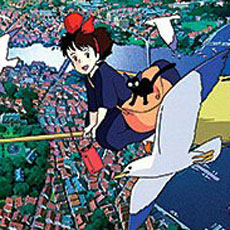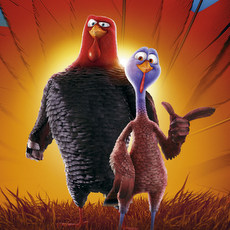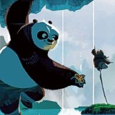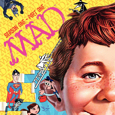Tokuma Shoten/Hakuhodo (March 11, 1984), Walt Disney Home Entertainment (February 22, 2005), 2 discs, 117 mins plus supplements, 1.85:1 anamorphic widescreen, Dolby Digital 2.1 Surround, Rated PG, Retail: $29.99
Storyboard:
A girl living in a post-apocalyptic world fights for her people against a poisonous jungle and its mutated creatures.
The Sweatbox Review:
Over the years, I have gone through my checklist of films that I really wanted to see someday. One by one, I have gotten the chance to see them, and to judge for myself whether or not they deserved their reputations. With Disney’s DVD release of Nausicaa Of The Valley Of The Wind, I was able to tick another film off of my list. I think it’s safe to say that I found that Nausicaa earned its reputation. It is known as Hayao Miyazaki’s early masterpiece, the first step towards creating his later renowned films Princess Mononoke and Spirited Away. Like Princess Mononoke, it carries an ecological message and features a princess who is close to nature. The other similarity is that both these “princess” films are absolutely terrific.

Nausicaa Of The Valley Of The Wind appeared first as a serialized manga (Japanese comic book story) by Miyazaki, appearing initially in Animage magazine. The manga was begun in 1982 and Miyazaki kept working on it until 1994, with intermittent breaks while he worked on his animated films. The documentary on the DVD says that the comic was specifically produced to secure financing for the 1984 movie version, although this is disputed in other accounts I have read. Regardless, the story in the film version differs significantly from the published one. It also only covers the early installments of the manga, similar to Otomo’s Akira. No matter how you experience Nausicaa, however, you are bound to be amazed and entertained.
I should note that there was an earlier video release of Nausicaa in North America, but it was heavily re-edited and renamed Warriors Of The Wind by New World Pictures. This was done legally, but not with the involvement of the film’s producers. The producers have kindly asked anime fans to disregard that version. Thank goodness that the true version is now finally available in North America!
Nausicaa is the heroine of the story, a princess who rides on a glider and has an almost mystical relationship with nature. She lives in a time 1000 years after a devastating global event that left the planet severely polluted. Humanity seems to be in its last days, as a poisonous jungle populated by huge dangerous insects spreads across the Earth and threatens to eradicate mankind. Nausicaa lives in The Valley of the Wind, in a village that is fortuitously placed in a location where the air is kept fresh by the continuous breezes. Still, spores from the jungle are an ever-present danger, as are stampeding insect life. Nausicaa’s own father is dying, assumedly from exposure to the jungle.

Early in the film, we meet up with an Ohmu, a monstrous being known as a king of the insects. This particular Ohmu, with rows of red eyes blazing, is chasing after a lone man on the back of a large bird. This man turns out to be the village’s legendary fighting master, Lord Yupa. Once Nausicaa assists Yuma by calming the Ohmu, they return to the village. There, a throng of happy villagers greets them, and we soon meet Nausicaa’s terminally ill father, and an old woman named Oh-baba. It is Oh-baba who tells the legend of a person dressed in blue who will help humanity again find its link with nature.
The next action spectacle in the movie takes place at night during a storm, when a huge Torumekian airship is seen to be losing altitude and seems certain to crash. Nausicaa flies up on her glider for a closer look, and sees that insects have attacked the ship. There is little for Nausicaa to do to prevent the crash, which is blunt in its terrible destruction. The mystery of the airship is enhanced by the discovery of prisoners from Pejite aboard the ship. A dying prisoner tells Nausicaa that the ship has a more horrible cargo, which must be destroyed. In the midst of this, there are fires to be put out, spores to be destroyed, and an insect to be lured back to the forest. The night has been very eventful, and it is apparent that the villagers’ relatively peaceful albeit imperiled existence is about to change significantly.

It is little surprise that Torumekian troops arrive the next day to investigate the crash, but the people of the Valley are surprised to find themselves under attack. There are high stakes being played for, and it all has to do with the mysterious cargo from the airship. Nausicaa fights the invaders, who have already attacked her father, and it is Lord Yupa that convinces her that the battle will be lost whether or not she is killed. Nausicaa then calms her people, who reluctantly agree to surrender.
Their captor turns out to be Princess Kushana of Torumekia. She is on a mission to bring the remaining kingdoms together and to eradicate the threat of the jungle. She intends to destroy the jungle with the aid of what was contained in the airship cargo. That cargo is actually an ancient gigantic being that holds great power. Oh-baba speaks up against the plan— she says that others who have risen against the jungle have seen their empires destroyed, and to battle the jungle with an evil force is foolhardy. Naturally, Kushana does not listen to the warning, and decides to send hostages back to Torumekia as insurance against the villagers rising against her troops as they make preparations. Nausicaa is to be one of the hostages.
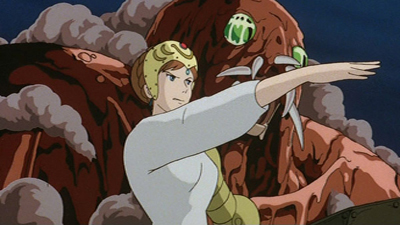
In the ensuing story, Nausicaa must escape and make allies in order to stop Kushana’s plan. The story is relatively complex, involving the actions of three kingdoms, each of which believes in its actions. Each has a different perspective on the jungle and what is to be done about it. Nausicaa remains at the center of the multi-faceted conflict, which also sees humans under attack repeatedly by insects (although only when provoked). There is also the mystery of the jungle — is it really a danger to mankind, or something else?
This film is a heck of a ride. Nausicaa is a prime example of why people keep saying that many of the best animated stories come from Japan. Those who long for complex stories that go beyond simplistic notions of good and evil should enjoy Nausicaa’s multi-leveled representation of events and characters. There are not really any villains here, simply a number of people trying to do the right thing, with one young girl showing a clarity of perception lost on the others. It may be fun to hiss bad guys, but it can be rewarding on a whole different level to see a group of characters with righteous yet opposing viewpoints come into conflict.
Despite the fantasy/sci-fi trappings of the story, the events seem startlingly real, thanks to the beautiful animation. It may not be as “full” as American feature films, or as “realistic” in style as some other anime, but the draftsmanship is admirable. Unique “you-are-there” perspectives bring the story to life and create a high degree of visual interest. It is only in the past few years that live-action films have been able to offer visuals so dynamic. There were many occasions that I audibly gasped as I marveled at Nausicaa soaring through the air on her glider, watched an Ohmu nearly trample a person, or sat stunned as airships went into ferocious battle. By the end of the movie, I was a bit pooped.

One of the most remarkable things about any Miyazaki film is the design of the creatures and props. Nausicaa is no exception, as it is filled with wondrous insects at once horrifying and beautiful, as well as formidable airships that stagger one in the immenseness they convey. Even if the story was not told as well as it is, the visuals alone would be enough to make this a movie to recommend. But, as it is, the story itself is unique and involving. I find that each Miyazaki film I see is a delightful surprise, largely due to the influences of the Asian myths and legends that infuse his stories, not to mention his own talent as a spinner of tales.
Is This Thing Loaded?
I can see some fans being disappointed in the Bonus Features here, but given the past Region 1 Miyazaki DVDs, this is a nice little set of extras.
First of all, though, there are the requisite Previews. Bambi, the three current Miyazaki releases, and The Incredibles are advertised before getting to the Main Menu, while one can also find trailers for the last wave of Miyazaki releases by going to the Extras menu.
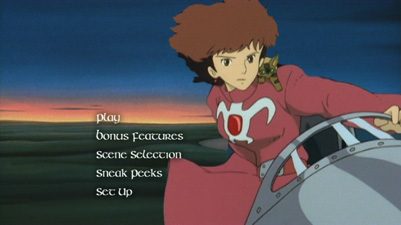
The real goods are coming up, though. Behind the Microphone (7:46) is an “okay” featurette with interviews of the American voice cast. They all seem very pleased to be associated with Nausicaa, with Mark Hamill appearing to be the most honored. My only complaint, really, is that this featurette is no substitute for what I would have preferred: more about the making of the film in Japan.
The next featurette, however, is one of the best of any of the Miyazaki Region 1 DVDs to date. The Birth Story Of Studio Ghibli (27:44) is a fine exploration of how Miyazaki got together with his partners to create the successful animation studio. The featurette basically has clips from a Japanese documentary or television spots dubbed in English. It was wonderful to learn more about the studio and the men behind it, and a fairly complete overview of their films is included, even if there is little commentary about most of them. Ironically, Nausicaa Of The Valley Of The Wind is itself not actually a Studio Ghibli film, as the studio was formed afterwards! Nevertheless, I will not complain about the inclusion of this nice bonus. (This is a small point anyways, since the top people are the same. Even the box art proclaims this as a Studio Ghibli film on the cover, although the credits on the back correctly state this is a “Top Craft” film.)
Japanese Trailers and TV Spots (8:28) is pretty self-explanatory. Most of them look much the same, but it is right that they should be included.
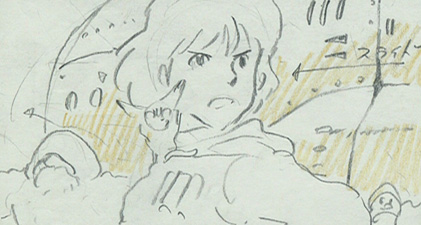
Disc 2 has what many would see as the best special feature in the set. Like most other catalog Miyazaki releases, the second disc of this set contains the Complete Storyboards for the film. Certainly, this is a great thing for students of animation, although many casual viewers may be bored. The storyboards may be viewed with either the English or Japanese audio track, and English subtitles are available here as well.
Oh, and being that THX supervised the transfer, their THX Optimizer is available as well. The fact that THX was involved is oddly not trumpeted on the cover, as I guess their symbol does not hold the same clout as it used to, in this age of (almost) consistently good transfers.
Case Study:
Disney, like a couple of other big studios, has fallen in love with the cardboard slipcase. Yes, it is exactly the same art and text that is presented on the keepcase cover, and no, I do not know what purpose it serves. However, studios seem to think that their top releases should have this cover, so it is nice to see that Miyazaki rates this treatment. The one good thing that I have found with the slipcase is that it makes it easier for me to mutilate the case’s cover to clip out proofs of purchase, since the disc’s case remains hidden under the slipcase.
Ink And Paint:
Disney has done a great job of transferring Nausicaa to DVD. The THX-certified 1.85:1 anamorphic image is perfect. Miyazaki’s traditionally muted color scheme keeps this disc’s video from “popping” like some other animated productions, but aside from that, this movie looks perfect. Compression problems are nil, and the two decade-old source material is surprisingly pristine.

Scratch Tracks:
Viewers are given a choice between the original Japanese track, and a 2003 English dub produced by Disney. In either case, there has been no 5.1 mixing, so all we get are 2.0 tracks. They service the film fine, but there is little in the way of directionality and certainly no bass. This was a small disappointment, but I suppose this is much like the film would have sounded in theaters back in 1984.

The quality of the English dub is quite good. Alison Lohman was well cast as the sensitive but strong Nausicaa, and consistently gives readings that capture the essence of this complex character. Patrick Stewart is Lord Yupa; he is as brilliant as ever, although his voice is so distinctive I almost wish that a lesser-known person was used. Mark Hamill, on the other hand, is unrecognizable as the mayor of Pejite— he’s great, but not anything like what I have heard from him before. Hamill is probably underestimated as a voice artist. Uma Thurman does well as Kushana; her voice is not distinct enough to distract, and she correctly avoids treating Kushana as a villain. Edward James Olmos gets a chance to be much more emotional as the soldier Mito than he is allowed by his Battlestar Galactica scripts. Chris Sarandon is appropriately smarmy as the Torumekian captain Kurotowa.
Final Cut:
This is a classic, all right. After all these years, my patience has been rewarded, and I found Nausicaa Of The Valley Of The Wind a sight to behold. Its engaging and mature storyline, dynamic animation, and bizarrely beautiful design captivated me from beginning to end. The audio is only serviceable, but okay for its age, and the video quality is perfect. Add in a nice featurette about Studio Ghibli, complete storyboards, and some American cast interviews, and you have a package that no anime fan will want to pass up. Once you get past the Disney classics, Nausicaa ranks right up there with the “greats” and needs to be watched.
 | ||
 |








